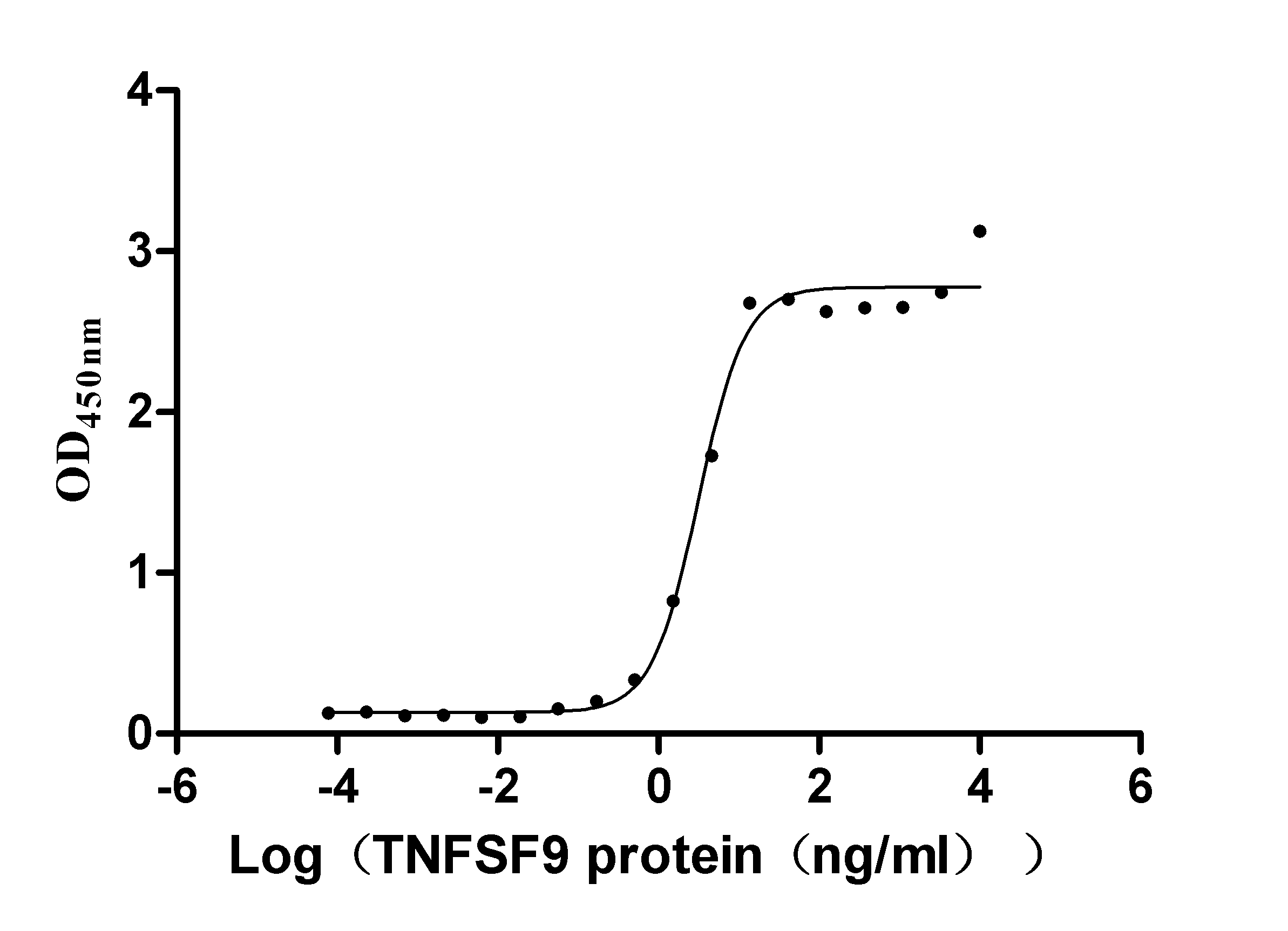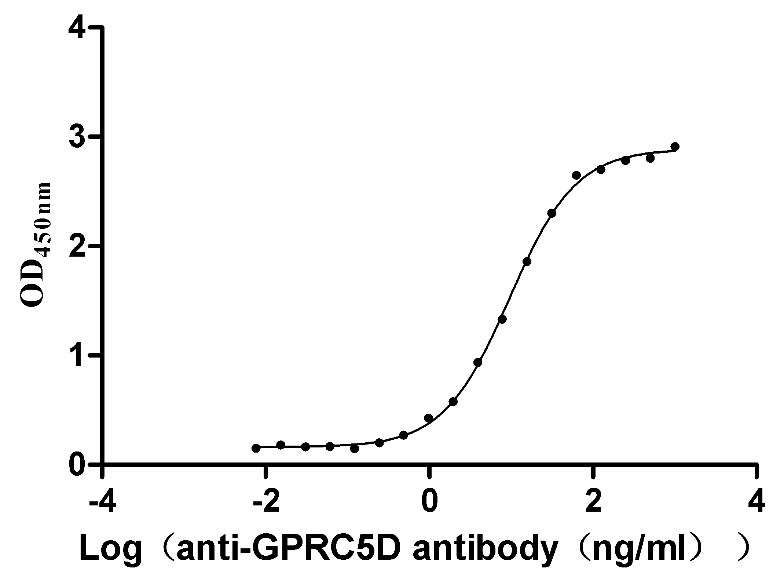Recombinant Arabidopsis thaliana Protein FLOWERING LOCUS T (FT)
-
中文名称:拟南芥FT重组蛋白
-
货号:CSB-YP871202DOA
-
规格:
-
来源:Yeast
-
其他:
-
中文名称:拟南芥FT重组蛋白
-
货号:CSB-EP871202DOA
-
规格:
-
来源:E.coli
-
其他:
-
中文名称:拟南芥FT重组蛋白
-
货号:CSB-EP871202DOA-B
-
规格:
-
来源:E.coli
-
共轭:Avi-tag Biotinylated
E. coli biotin ligase (BirA) is highly specific in covalently attaching biotin to the 15 amino acid AviTag peptide. This recombinant protein was biotinylated in vivo by AviTag-BirA technology, which method is BriA catalyzes amide linkage between the biotin and the specific lysine of the AviTag.
-
其他:
-
中文名称:拟南芥FT重组蛋白
-
货号:CSB-BP871202DOA
-
规格:
-
来源:Baculovirus
-
其他:
-
中文名称:拟南芥FT重组蛋白
-
货号:CSB-MP871202DOA
-
规格:
-
来源:Mammalian cell
-
其他:
产品详情
-
纯度:>85% (SDS-PAGE)
-
基因名:FT
-
Uniprot No.:
-
别名:FT; At1g65480; F5I14.3Protein FLOWERING LOCUS T
-
种属:Arabidopsis thaliana (Mouse-ear cress)
-
蛋白长度:full length protein
-
表达区域:1-175
-
氨基酸序列MSINIRDPLI VSRVVGDVLD PFNRSITLKV TYGQREVTNG LDLRPSQVQN KPRVEIGGED LRNFYTLVMV DPDVPSPSNP HLREYLHWLV TDIPATTGTT FGNEIVCYEN PSPTAGIHRV VFILFRQLGR QTVYAPGWRQ NFNTREFAEI YNLGLPVAAV FYNCQRESGC GGRRL
-
蛋白标签:Tag type will be determined during the manufacturing process.
The tag type will be determined during production process. If you have specified tag type, please tell us and we will develop the specified tag preferentially. -
产品提供形式:Lyophilized powder
Note: We will preferentially ship the format that we have in stock, however, if you have any special requirement for the format, please remark your requirement when placing the order, we will prepare according to your demand. -
复溶:We recommend that this vial be briefly centrifuged prior to opening to bring the contents to the bottom. Please reconstitute protein in deionized sterile water to a concentration of 0.1-1.0 mg/mL.We recommend to add 5-50% of glycerol (final concentration) and aliquot for long-term storage at -20℃/-80℃. Our default final concentration of glycerol is 50%. Customers could use it as reference.
-
储存条件:Store at -20°C/-80°C upon receipt, aliquoting is necessary for mutiple use. Avoid repeated freeze-thaw cycles.
-
保质期:The shelf life is related to many factors, storage state, buffer ingredients, storage temperature and the stability of the protein itself.
Generally, the shelf life of liquid form is 6 months at -20°C/-80°C. The shelf life of lyophilized form is 12 months at -20°C/-80°C. -
货期:Delivery time may differ from different purchasing way or location, please kindly consult your local distributors for specific delivery time.Note: All of our proteins are default shipped with normal blue ice packs, if you request to ship with dry ice, please communicate with us in advance and extra fees will be charged.
-
注意事项:Repeated freezing and thawing is not recommended. Store working aliquots at 4°C for up to one week.
-
Datasheet :Please contact us to get it.
靶点详情
-
功能:Component of the mobile flower-promoting signal (floral stimulus or florigen). Promotes the transition from vegetative growth to flowering. Required for 'SEPALLATA3' (SEP3) and 'FRUITFULL' (FUL) accumulation in mature rosette leaves. Seems to acts in parallel with 'LEAFY' to induce flowering by regulating 'APETALA1'. Translated in leaves and then transported to the shoot apical meristem where it activates the transcription of several floral meristem identity genes. May play a role in both the autonomous and the long-day flowering pathways.
-
基因功能参考文献:
- role of FT in flowering PMID: 28965831
- FT in Arabidopsis thaliana is produced in two unique files of phloem companion cells. PMID: 29483267
- FT expression during night time temperatures and flowering PMID: 26856528
- Variation in shade-induced flowering in Arabidopsis thaliana results from FLOWERING LOCUS T allelic variation. PMID: 29117199
- Study conclude that thermoperiodic control of floral transition is associated with modulation of the diurnal expression patterns of FT, with timing of temperature alteration being important rather than average daily temperature. PMID: 28028164
- Results demonstrated that meristematic FT overexpression generates a phenotype with an early flowering independent of photoperiod when compared with wild type (WT) plants. PMID: 27154816
- AtFT-induced flowers were morphologically normal and produced viable pollen grains and viable self- and cross-pollinated seeds. PMID: 26132805
- Post-translational mechanisms might control FT protein abundance. PMID: 26548373
- The temporal pattern of FT expression encodes information that discriminates long days from other inputs. Accelerated flowering requires high FT expression over several days. PMID: 26212862
- FE protein promotes flowering through transcriptional activation of FT and Ftip1. PMID: 26239308
- Induced and natural variation of promoter length modulates the photoperiodic response of FT protein. PMID: 25087553
- Specific mutations in at least four different residues are sufficient to convert FT into a complete TFL1 mimic, even when expressed from TFL1 regulatory sequences. PMID: 24532592
- FT binds to diurnally oscillating phospholipids that accelerate flowering. PMID: 24698997
- SUPPRESSOR OF OVEREXPRESSION OF CONSTANS 1 (SOC1) and FT regulate the SPL3, SPL4 and SPL5 genes by directly binding to the gene promoters in response to photoperiod signals. PMID: 21988498
- These results emphasize the expanding role of FT in affecting general determinate growth. PMID: 23333977
- FT protein enters the phloem translocation stream and subsequently exits the phloem and enters the apical tissue, where it initiates the vegetative to floral transition. PMID: 23607279
- the cotyledon is an important organ for producing FT protein to induce flowering PMID: 23204014
- PHYTOCHROME AND FLOWERING TIME1 (PFT1), MED25, is degraded by the proteasome and proteasome-mediated PFT1 turnover is coupled to its role in stimulating the transcription of FLOWERING LOCUS T. PMID: 22992513
- Both FT RNA and protein move long distance and act redundantly to integrate the photoperiodic signals. PMID: 22614833
- FT acts downstream of miR156 and SPL3. PMID: 22427344
- FLOWERING LOCUS T PMID: 22442143
- Loss of polycomb group protein repression causes down-regulation of FT. Chromatin changes are not key factors in determining FT spatial expression. PMID: 21917549
- GI can bind to three FT repressors: SHORT VEGETATIVE PHASE (SVP), TEMPRANILLO (TEM)1, and TEM2. PMID: 21709243
- temporal separation of reproductive onset and vegetative growth into different seasons via FT1 and FT2 provides seasonality and demonstrates the evolution of a complex perennial adaptive trait after genome duplication PMID: 21653885
- Data show induction of rapid flowering in apple seedlings at 1.5-2 months by using the Apple latent spherical virus (ALSV) vector expressing a FLOWERING LOCUS T (FT) gene from Arabidopsis thaliana. PMID: 21132560
- Distant regulatory regions are required for FT transcription, reflecting the complexity of its control and differences in chromatin status delimit functionally important cis-regulatory regions. PMID: 20472817
- Results indicate that allelic variation at pathway integrator genes such as FT can underlie phenotypic variability and that this may be achieved through cis-regulatory changes. PMID: 19652183
- Reduction of FT mRNA in COL9 overexpressing lines of A. thaliana delays flowering. PMID: 16115071
- We propose that FT functions through partner-dependent transcriptional activation and that this occurs at several sites. Organ fate may depend on both degree of activation and the developmental stage reached by the organ before activation occurs. PMID: 16155177
- NTL8 mediates salt-responsive flowering via FT in Arabidopsis. PMID: 17410378
- it is concluded that that FT protein acts as a long-distance signal that induces Arabidopsis flowering PMID: 17446353
- To our knowledge, FT is the only known protein that serves as a long-range developmental signal in plants. PMID: 17540569
- We demonstrate that export of FT protein from phloem companion cells is sufficient to induce flowering. PMID: 17540570
- acts redundantly with TSF and SOC1 to promote flowering in response to CONSTANS and far red enriched light PMID: 18667727
- TEMPRANILLO genes (TEM1 and TEM2) act as novel direct FT repressors. PMID: 18718758
- Photoresponses are important for up-regulation of FT and for flowering. PMID: 18836142
- FLOWERING LOCUS T protein activity is transmissible through a graft junction and can promote flowering from a distance. PMID: 18849573
- FT and gibberellin act both independently and interactively in LD floral signalling. PMID: 18931352
- identification & characterization of CIB1 (At4g34530) protein; CIB1 stimulates FT messenger RNA expression, and it interacts with chromatin DNA of the FT gene that possesses various E-box elements except G box PMID: 18988809
- Reducing FLC levels in Bla-6 can induce FT expression and early flowering with low red light. PMID: 19563438
显示更多
收起更多
-
亚细胞定位:Cytoplasm. Nucleus. Endoplasmic reticulum.
-
蛋白家族:Phosphatidylethanolamine-binding protein family
-
组织特异性:Mostly localized in leaves vasculature.
-
数据库链接:
KEGG: ath:AT1G65480
STRING: 3702.AT1G65480.1
UniGene: At.469
Most popular with customers
-
Recombinant Human Tumor necrosis factor ligand superfamily member 9 (TNFSF9), partial (Active)
Express system: Mammalian cell
Species: Homo sapiens (Human)
-
Recombinant Human T-cell surface protein tactile (CD96), partial (Active)
Express system: Mammalian cell
Species: Homo sapiens (Human)
-
Recombinant Human G-protein coupled receptor family C group 5 member D (GPRC5D)-VLPs (Active)
Express system: Mammalian cell
Species: Homo sapiens (Human)
-
Recombinant Human Killer cell immunoglobulin-like receptor 3DL2 (KIR3DL2), partial (Active)
Express system: Mammalian cell
Species: Homo sapiens (Human)
-
Recombinant Human Myosin regulatory light chain 12B(MYL12B) (Active)
Express system: E.coli
Species: Homo sapiens (Human)
-
Express system: Mammalian cell
Species: Homo sapiens (Human)



-AC1.jpg)














